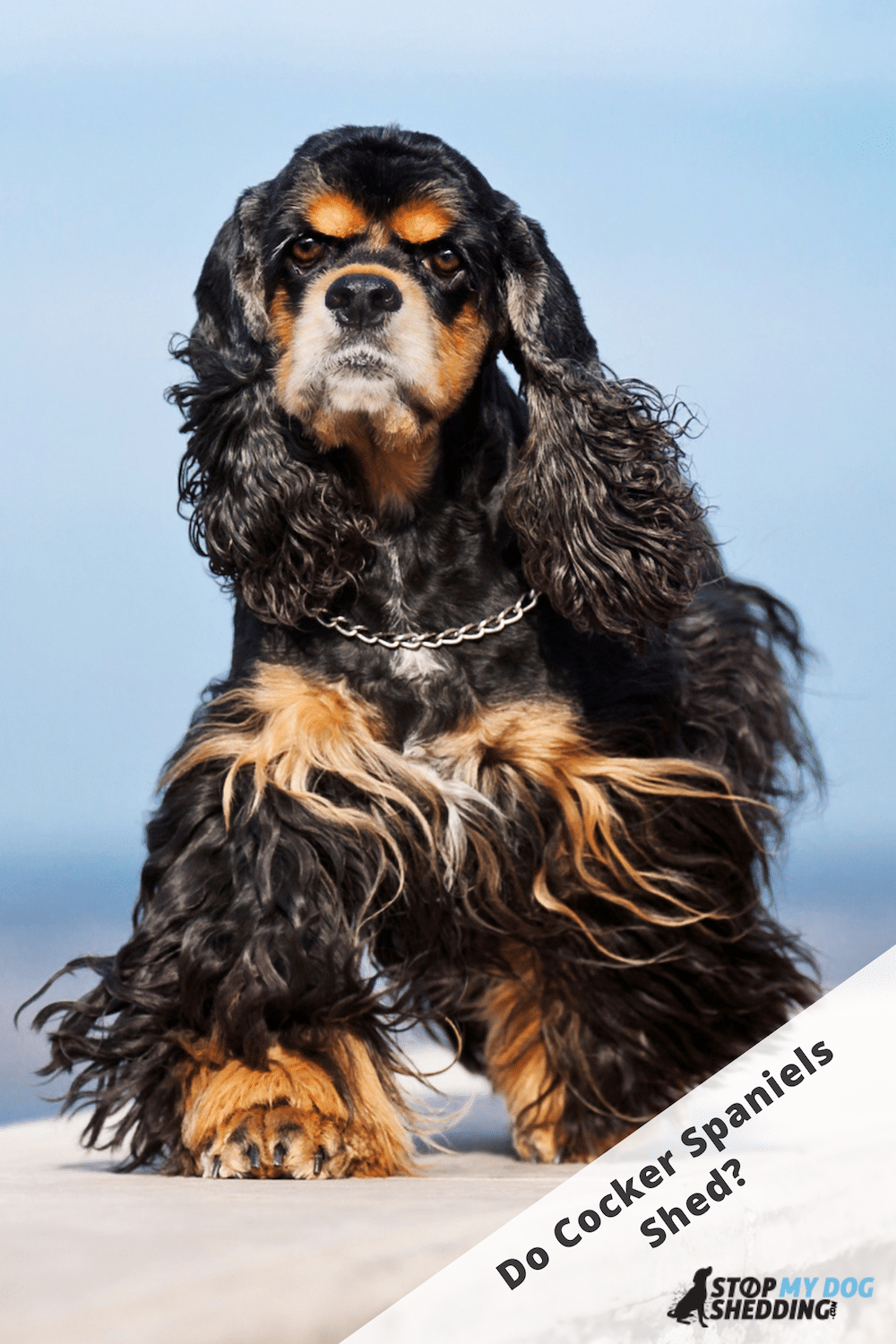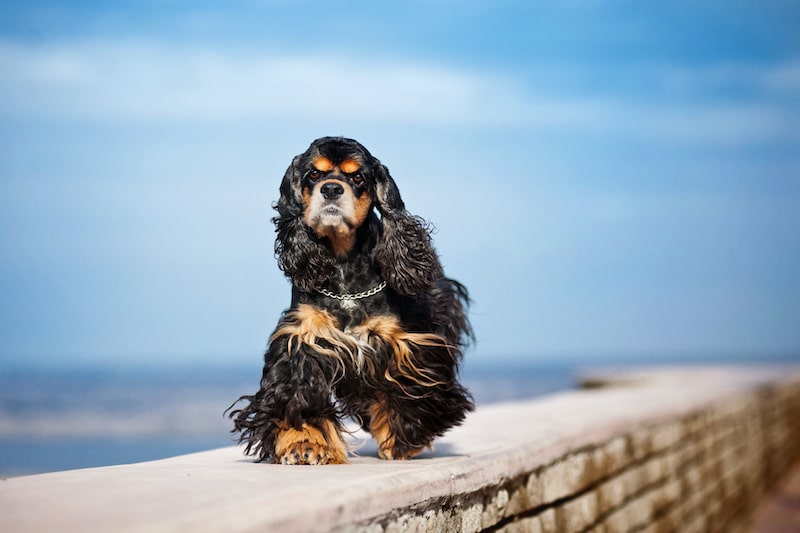Cocker Spaniels are small, gentle, adorable dogs, and one of the most popular family companions in the United States. But they’re not just a pretty face. Spaniels were originally bred to hunt and retrieve game birds, so they are naturally active and alert sporting dogs too.
Do they shed much?
Cocker Spaniels have a double coat that sheds moderately year-round, and more during periods of seasonal shedding once or twice a year. They also have fairly high maintenance coats that require regular brushing to prevent matting and to help manage the shedding.
Let’s take a closer look at the Cockers coat, just how much shedding they do and what they’re like to groom, so that you have a better idea of what to expect.
Cocker Spaniel Coat Overview
Cocker Spaniels have a double coat, which means that instead of having just one layer of hair, they have two – an outer coat and an undercoat.
The outer coat is short and fine around the head, and longer around the rest of the body. Especially around the chest and underside of their body, and around their ears. The texture of the coat is silky and either flat or a little wavy and the colors vary greatly.
The undercoat is short and dense, and helps to keep Cockers from getting too cold or too hot, it basically helps insulate them. Which is ideal for sporting dogs like the Cocker, but this can increase the amount of shedding and effort needed to groom them.
However, it does depend on which Cocker Spaniel you get as to exactly what sort of coat he will have. Because there are two different types: the American Cocker Spaniel and the English Cocker Spaniel.
What’s the difference between English and American Cockers?
Both were considered the same breed until the 1940s, so they share a lot of similar traits. And because the American Cocker Spaniel is simply called “Cocker Spaniel” in the United States, there has been some confusion over the differences. However, there are some distinctions.
For example, the English is taller, while the American is slightly longer and has a more rounded skull. Also, the American has more hair on their coat overall, and the hair is longer with more feathering.


Do Cocker Spaniels have hair or fur?
There is a common debate in dogdom that centers around whether or not there’s any difference between hair and fur. And the short answer is no – there is no difference. If you put “hair” and “fur” under the microscope, you’d see they look exactly the same and they are both made from a protein called keratin.
However, some experts believe that “hair” is unique in that it takes longer to grow. Or more specifically, that it has a longer growth cycle. Which in turn is something that is typically associated with dogs that shed less. And this is why some who have dogs that don’t shed will boldly proclaim the reason for this is “because they have hair.”
Are they hypoallergenic?
Cocker Spaniels are not considered to be a hypoallergenic dog breed. So if you’re looking for a dog that won’t upset your allergies, the Cocker may not be the best choice.
No dog is ever completely hypoallergenic though, not even hairless breeds. It’s just that some are generally considered more suitable for allergy sufferers than others. Mostly because their coat doesn’t produce much dander and they don’t shed much.
Cocker Spaniel Shedding – What to Expect
Cocker Spaniels are a moderate shedding breed.
To help put this into perspective, they shed about the same amount of hair as a Cavalier King Charles Spaniel and English Springer Spaniel.
So you’ll notice some hair around the home, especially if you don’t keep on top of the brushing. And you may notice an uptick in molting during seasonal changes, like spring and fall, for a few weeks or so.
But nothing too extreme. If you were to compare them to heavy shedders like the Saint Bernard or Labrador Retriever, you’d quickly see that it’s nowhere near as noticeable.
With that being said, they do tend to molt more than low shedding breeds, like the Irish Water Spaniel for example. So if you’re looking for a dog that is as close to “non-shedding” as you can get, the Cocker Spaniel isn’t it.
Grooming Your Cocker Spaniel
When it comes to grooming, Cockers are fairly high maintenance. They require regular and thorough grooming sessions.
And the main reason for this is because of the length of their coat, in particular the feathered areas. These are prone to mats, knots and tangles that need to be removed as they can cause pain and discomfort for your dog.
But it’s also because they have large, delicate ears that you need to take care around when brushing, and the fact that their coat needs regular trimming in places to keep it at an appropriate length.
The amount of time and effort, or money spent on grooming services, does depend on how fussy you are about maintaining the coat’s shininess and whether or not you clip him though.
Most owners simply have him clipped professionally every couple of months to make life easier. Because this can save you some brushing and help avoid mats and knots. And this is often accompanied by a thorough bath and things like nail trimming.
So this is an option that can save you some time. Just keep in mind that paying someone to groom your Cocker isn’t going to be cheap, it will likely cost you hundreds of dollars per year.
Either way, Cockers need to be brushed a few times per week, some even brush daily, to maintain their coat and to help manage the shedding. And if you bathe him yourself, just keep in mind that it’s important to only ever use a good quality dog shampoo that doesn’t dry out, or irritate, his skin. As this can cause problems and increase the shedding.
How do you brush a Cocker and what brush is best?
The most suitable type of brush is probably a metal comb, as these are very effective at helping you work out any mats and tangles carefully over the coat. And what we often do is followup with a slicker brush, as these work well at removing the loose hair and finishing the job.
You could also use a deshedding tool to make it easier to remove the old hair during shedding season, but this is optional. And if you do choose this type of brush, avoid using it too often as it may lead to skin irritation.
How Do You Reduce Shedding?
The best way to reduce shedding in your Cocker Spaniel is to make sure his diet is optimal, which your vet should be able to help you with, and to keep up with regular, thorough grooming.
Proper nutrition matters because it can help your dog maintain his optimal health. Which can, as a result, limit the possibility of excessive shedding caused by poor diet. And at the same time, help improve his coat. And a healthier coat often leads to stronger hair follicles which in turn can mean lower shedding.
Brushing also helps because when you brush you are spreading the natural oils of his skin, which can improve the condition of the coat. And of course, brushing removes the old, dead hairs before they have a chance to fall off and onto your floors, furniture and upholstery.
These two things alone (proper diet and regular brushing) can make the world of difference as to how much he sheds and how much time you spend vacuuming. And they’re pretty simple really. It’s just a matter of keeping up with a regular routine.
There are other ways to limit shedding too, such as bathing with a proper dog shampoo prior to brushing for example, which can help you win the battle against shedding.
With that being said, if you’re noticing an excessive amount of shedding and you don’t think it’s “normal” then it might be worth contacting your veterinarian. Because sometimes this can be caused by things like stress, fleas or allergies, among other things.
Bottom Line
Cockers do molt, but it’s typically not as noticeable as it is with large, heavy shedding dogs. And with proper grooming, it’s not difficult to manage. However, there are lower shedding, easier to groom dogs out there. Such as the Basenji.
So, while Cocker Spaniels are an amazing breed, if you can’t stand seeing hair floating around, and you want a dog that rarely needs brushing, there are some better alternatives to consider.













How do i get him not to bite when im brushing him
Probably best to speak to a professional dog trainer, or even your local vet, about that.
One of my dogs doesn’t like being brushed either, so I use a rubber grooming glove instead. This was a good solution for me since he basically reacts to the grooming glove in the same way he does being pat, and these can still work really well.